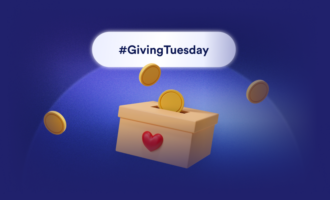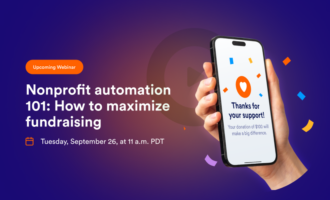How to make a fundraising calendar
- Include realistic monthly and annual goals
- Pinpoint the important hard and soft deadlines
- Identify your audience for each campaign
- Keep an updated account of your finances
What is a fundraising calendar?
A fundraising calendar keeps track of important steps and dates for a fundraising campaign. Fundraising calendars are used to plan and manage fundraising efforts and ensure that each step goes smoothly. These calendars help nonprofits prioritize their fundraising goals and visualize how they plan to meet those goals.
What are the benefits of a fundraising calendar for nonprofits?
There are many benefits to using fundraising calendars. In addition to providing an organized timeline for a fundraising campaign, fundraising calendars are also great tools for coordinating with team members, predicting outcomes, and holding team members accountable during the process. The benefits of fundraising calendars include
- Improved coordination. Align with your team about the goals and expectations of your fundraising campaign. Share insights and align on data with Jotform’s easy-to-use interface to stay on the same page before, during, and after your campaign.
- More accurate predictions. Fundraising calendars can give your nonprofit the insight it needs to forecast how much your fundraiser will net. If you make realistic projections, you can use that information to create budgets and inform future spending decisions.
- Greater accountability. Ensure that your team is meeting goals and making strides in your fundraising campaign. Fundraising calendars require planning and goal-setting, setting up expectations at the start and holding each team member accountable for their share of the work.
Strategic fundraising for nonprofit organizations requires a detailed plan and a fundraising calendar — a tool that helps nonprofits organize when and how they’ll achieve their fundraising goals. A fundraising calendar is an essential resource a nonprofit’s leadership can consult regularly.
The fundraising calendar, which usually takes the form of a spreadsheet, outlines key information about the current year’s fundraising strategy, including
- How much money the nonprofit is looking to raise
- The various planned activities
- Dates and deadlines for each activity
- Details regarding the targeted donor segment for each activity
- Details on expenses and income
Below are some tips related to each of the above areas to help you create a thorough and informative fundraising calendar for your nonprofit.
1. Include realistic monthly and annual goals in your fundraising calendar
Base your calendar on your nonprofit’s fiscal year. First, consider your annual macro fundraising goal for the coming year and how you’ll earn those donations throughout the year.
Some nonprofits have a fairly even cadence of incoming donations every month. Others tend to bring in more donations during certain months of the year. Look through your historical data to determine the best way to approach goal setting.
Be sure to consider
- Year end. This is typically a popular time for nonprofits to make appeals to donors, because they’re more likely to be generous. As a result, you may have a larger fundraising goal for November and December.
- Recurring events. If your nonprofit holds an annual event in line with its mission (such as for Breast Cancer Awareness Month), this may be another time period when your donation goal is larger.
- Slow periods. For many nonprofits, certain seasons (such as summer) are slower than others. You may have to schedule more events during those months to boost your exposure — and hopefully your donations.
Determine your monthly goals for each quarter so you have a solid milestone to consult every three months. This will help you see if you’re on track to meet your annual fundraising goal.
2. Pinpoint the important hard and soft deadlines
Once you’ve assigned donation goals for each month of the year, add to your calendar the important dates your team needs to be aware of to meet those donation goals. These dates will include
- In-person or virtual events. Note the dates of whatever activities you’ve planned — galas, dinners, silent auctions, benefit performances, or anything else — on the calendar.
- Campaign start and end dates. Add direct mail, email, or social media campaigns that support in-person and virtual fundraising events to your calendar.
- Grant deadlines. Make note of application due dates for specific grants related to your locality or mission.
- Important meetings. Include the dates of monthly or annual board meetings, budget meetings, and trustee meetings that can impact donation goals and available resources.
Once you’ve noted the hard, immovable deadlines, add “soft” deadlines, such as when you’ll be preparing to meet the hard deadlines. For example, you may have to start preparing in September for an event you’re hosting in December.
3. Identify your audience for each campaign
Building a personal connection with your donors is key for any nonprofit organization, as it inspires people to give generously. For each event or campaign you’ve specified in your fundraising calendar, identify the donor segment you’ll target. For example, if you’re holding a silent auction in a school, you may want to target parents in that community.
By segmenting your donors, you can avoid appealing to them too frequently. Keep in mind that several other nonprofit organizations may be asking for donations at the same time. To avoid overwhelming your audience, segment them in your fundraising calendar and track when you last made an appeal or engagement.
Consider segmenting donors by demographic or donor status, such as planned donor, major donor, and new donor.
4. Keep an updated account of your resources, expenses, and income
To effectively track how close you are to reaching each monthly fundraising goal, be sure to track the output of resources as well as the input. Include columns for
- Financial resources. Include your required budget for an event or campaign — for example, to rent a community center hall or purchase software for an online event.
- Volunteer hours. Note how many hours are required to execute the event or campaign — such as 15 hours to design, implement, and monitor a social media ad for an upcoming gala.
- Income. Calculate the funds you’ve raised minus the expenses. Be sure to compare the total to the expected fundraising goal and determine if you were over or under your projection.
Once the year is over, your calendar can still be useful — it can inform your efforts for the following year. Do a year-end review and evaluate where and how you can improve. Do you need more or less time to plan a particular event? More or fewer volunteers? Which fundraising efforts fell short of their goals?
By strategically planning your fundraising activities and then reviewing them afterward, you’ll be more likely to reach your donation goals going forward. Build your own donation app with Jotform Apps to fundraise seamlessly. Add the Donation Box element to your app to set up the payment processor of your choice, include a progress bar, and set custom donation amounts. Then simply share your app with your audience through a link, on your website, through a QR code, or on your website to start collecting donations.

























Send Comment: